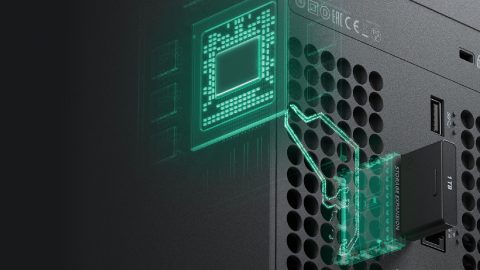
Idon’t remember my first Steam Deck ‘I can’t believe it can do this’ moment and that’s probably because there have been so many of them. The giddy new tech squees that feels like maybe, just maybe you might be touching the overgrown GameGear-shaped future. The first might have been when I was sitting on the sofa watching a stream announce a demo for a game, downloading it from the store, and seamlessly playing it 5 minutes later without having to change a single setting or move a muscle.
Or maybe it was noticing I was playing Doom Eternal at 60fps without a hiccup. Or perhaps when I paired a new set of Bluetooth noise-cancelling headphones within seconds. Or realised I could play Itch.io games and suddenly was experiencing the monochrome delights of Kids using just the touch screen. The versatility of the Steam Deck can’t be underestimated.
But, let’s rewind for a minute. Valve’s Steam Deck, effectively a handheld Linux gaming PC designed for portable access to your Steam library, was first released back in February 2022. It comes in three different flavours. A 64GB model with eMMC storage for £349, 256GB model with a faster NVMe SSD for £459, and then the 512GB model with what Valve calls the ‘fastest’ NVMe SSD with a bonus anti-glare glass screen for £569.
All models come with a handy – not to mention surprisingly solid – carry case with handle and the top two come with an exclusive Steam Community profile bundle. It’s worth saying that if you’re looking to buy one, Steam is currently citing a wait time of at least until October 2023. For the purpose of this review, I’ve spent a month with the mid-range model.

On release, reviews for the Steam Deck were mixed with many reviewers citing slews of bugs and pronouncing that the console just wasn’t ready for release. The good news is that almost five months on and the Steam Deck is very much ready now. Updates from Valve are regular and I can count on one hand any bugs I’ve encountered. The most memorable of which certainly wasn’t dramatic with a game losing audio after the console being asleep for a while, prompting a restart. Basically the bug equivalent of a shrug emoji.
After reading early feedback, I was especially surprised by just how slick everything feels. Choose a game from your library, load it up, and the Deck will tell you which control scheme the game is automatically set to. If a game has a controller set up as standard, a handy onscreen Steam Deck will briefly show you the analogue sticks and buttons highlighted, if you need a mouse, you’ll see the haptic trackpads glowing instead. And if you want to customise these further, the Steam Deck is happy for you to do that.
The physical design of the console is where so much of its versatility lies. If we go on a quick tour of the almost comically chunky handheld, you’ve got your directional buttons, analogue sticks, face buttons, two pleasingly reactive haptic trackpads, the menu and guide buttons positioned on either side of the touch screen, a Steam button, and what’s called the Quick Access button to let you change performance options etc on the fly. Flip the console and there are solidly reassuring shoulder buttons and four rear paddles that can be programmed in the controller settings. Up top are your volume and power buttons as well as a USB-C charging port.
Layout wise, everything feels compact around the vibrant HD screen and yes, the directional and face buttons do look perilously close to the edge of the console, but in practice this doesn’t distract in game. Nintendo Switch players will notice the additional eight and a half ounces of weight at first but the Steam Deck never feels particularly hefty in hand, and playing on the sofa is perfectly comfortable. Although play House Flipper – or your chosen meditation game – for too long in bed and you will find the usual Vita/Switch arm ache and have to switch position. Games without native controller support are dealt with deftly too. The trackpads are sensitive enough for accurate control – yes, I’ve even played Getting Over It with Bernard Foddy – and the touchscreen often comes in exceptionally handy for more accurate clicks. It’s accurate enough too, although not tremendously oleophobic. After a session of Stacklands, my Steam Deck looked like an iPad after a run in with a sticky fingered toddler. A microfibre cloth is an essential accessory.

Important to note too are the fans. There are vents on both the rear and the top of the console and you will gradually get used to them running, but at first the heat and noise might be a bit of a shock. It entirely depends on the game you’re playing as to just how loud they’ll get – and an update has reduced the noise somewhat – but they’re never loud enough that you can’t gently up the volume to balance things out. Oh, and speaking of volume, the Steam Deck’s stereo speakers, sitting on the front of the console are exceptional. Whether you’re listening to bullets whizz through the air in Sniper Elite 5 or the satisfying sound of a high pressure hose bouncing off a giant plastic dinosaur in Powerwash Simulator, the soundscape is rich and vibrant. Alternatively, Bluetooth connectivity means you can speedily hook up a wireless headset as well as other accessories like mice, keyboards, or even an Xbox controller.
And oh yes, games. Which ones can you play and how well do they run? Well, that’s all helpfully outlined by the slick UI. Once you sign into your Steam account, Valve has helpfully separated your library into ‘Great on Deck’ and then, well, everything else. Great on Deck means the game is verified to run on the system with a green tick proudly displaying compatibility, but that doesn’t mean the rest of your library is lost. Click through the rest of your library and you’ll quite often see a yellow circle with an ‘i’ inside which means that the game does play but there might be a few compatibility warnings. You can click into the game and check these out in the info section. You might need to occasionally manually invoke the onscreen keyboard with a press of the Steam and X buttons, some text might be too small and difficult to read, or you might need to use a combination of the touch screen and other buttons.
Other games won’t even have been tested so you’ll have a question mark next to each one basically asking you to try it out and see. Thankfully these icons are also clear on the Steam Store so you’ll always know what you’re buying. Sadly though there are some titles with just a no entry sign so if you’re counting on a Steam Deck being a machine for just one game, do check online if it’s playable on Deck. This can be for anti-cheat reasons or even just the code not playing ball with the Deck. The majority of games are playable and I’ve even seen my Great on Deck section grow by ten or so games in the last month but there are definitely limitations here. Where this is most fun to test is with demos as there’s no need to worry about whether the game will run or not and there’s a real sense of smug when you find a brand new demo that just runs perfectly thanks to controller recognition. And it’s with noting too that this isn’t just a gaming UI, press the Steam button and you can switch to the desktop mode of the handheld Linux PC. It’s here you can run installers like itch.io, add them as non Steam games and then see them in the gaming UI. It’s a powerful and impressive toolset.

Performance wise, the Steam Deck is pretty much a marvel but also a balancing act and here’s where the battery limitations come in too. In practice, yes, the Steam Deck can play some triple A games at up to 60fps but if you want to play them consistently for any length of time, you’re going to want to dive into the Quick Access menu and ingratiate yourself with the performance settings. In here you’ll find a performance overlay to see how many frames you’re hitting, as well as projected battery life to let you see the direct effect in hours and minutes of adding hard frame rate limiters, switching up the refresh rate, and limiting thermal power. The Steam Deck’s AMD GPU is powerful but it’s knowing how to use it and being agreeable to how much you’re willing to sacrifice to play on the sofa or on the go. The Steam Deck Dock for use with your TV has been delayed but the handheld does work with some USB-C to HDMI adaptors.
PC tech heads will love fiddling with individual settings in conjunction with game options but even just limiting frame rate makes a huge difference. Doom Eternal with no frame rate limit on High settings with a limited resolution will let you slicky execute monsters for an hour and a half, while dropping to 30 will give you two hours 23 minutes. But whether you want to play Horizon Zero Dawn on a handheld with original settings at between 30-40fps, or just play Sniper Elite 5, you will find the battery lacking if you want to play the Steam Deck out and about. Valve says that the battery can range up to eight hours but I haven’t been able to find even the simplest indie that can do that. The Binding of Isaac: Rebirth clocked up a respectable five and a half though so there are games out there you can grab for train and plane journeys if you don’t mind popping this in a bag and potentially keeping an eye out for a plugpoint.
Where the Steam Deck positively sings is as a sofa PC. As the access to all – or at least most – of the games you want to play but don’t want to sit at your work desk to play. The little Steam Next Festival demos that you can hurtle through. The games you always meant to get around to but can now play while you’re watching TV. It sounds silly but in the month since I got the console, I’ve reconnected with my Steam library in a whole new way. It’s no longer a terrifying behemoth of unplayed rash Steam sale purchases but an instantly accessible playground that can sit alongside a cup of tea and a blanket. The Switch still claims the simplest, most portable option but the Steam Deck is a literal game-changer when it comes to unshackling yourself from your gaming PC.
The Verdict
The Steam Deck does have limited battery issues but its power and sheer versatility when it comes to controls, mean that this is a handheld with exceptional gaming chops.
Pros
- Great performance
- Your Steam library in a handheld
- Ultra versatile controls
Cons
- Limited battery life
- Fans can get noisy
The post Steam Deck review: a marvel of a miniature gaming PC appeared first on NME.





